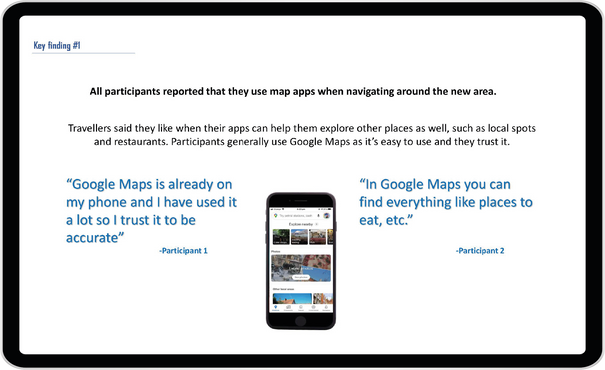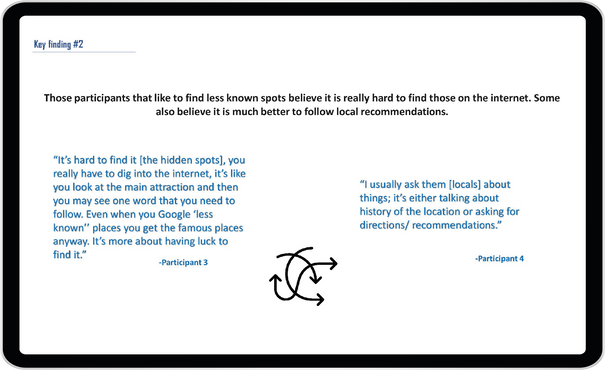Project Type
End-to-End Product Design
Tools
Adobe XD
Miro
Adobe Illustrator
Duration
10 weeks (2021)
Methods
Secondary Research
Primary Research (User interviews)
Data analysis
Affinity Mapping
Complexity Quadrants
Wireframing
High-fidelity design
Usability Testing
User Testing


BACKGROUND
Overview
As a final project for my UX Design Nanodegree program I implemented the entire UX design process from conception to completion. The project's objective was to design a new product through a full user experience journey which began with research and problem identification and progressed through ideation and prototyping before concluding with usability testing and refinements. I concentrated on developing a solution centered around the user which maintains a balance between business objectives and an intuitive engaging user experience.
PRODUCT OVERVIEW
What is Wonder?
Wonder is an app for frequent travellers, that helps them explore the local area and immerse into the local culture. As part of this product user will be able to explore the area on the map and find interesting and less known local spots, such as landmarks, monuments and paths, all added and recommended by the local people. This way they will be able to connect with locals and find less known and less touristy places in the area they are travelling to.
Who is Wonder for?
Our desired audience are travellers between 20-50 y.o. who frequently travel for leisure. They are people who commonly plan their trips reading blogs, watching YouTube or scrolling through Instagram or Pinterest to find interesting places on their next trip. However, they would also be people who have everyday jobs and don’t have that much time to be planning their trip, so the accessibility and reliability of the information on our App are their priorities.
RESEARCH

Secondary research
The first step of this project was to conduct secondary research, to understand the market, possible value and need for this type of project. As part of this research, I have read multiple articles on how travel changed in recent years, assessed competitors and what is currently offered for sale for our audience group.
Travel has became a very popular activity in the recent years. Statistics show that Millennials who make up 20% of all travellers studied by Project Time Off take average 7 trips per year.
Primary research
My goal was to understand the real demand for an app that helps travellers discover hidden and less-known spots in the areas they visit. I aimed to find out how many adult travellers rely on their phones to navigate new places and whether they genuinely desire to immerse themselves deeper into the local culture and surroundings — or if most are simply content with visiting the popular, well-known attractions.
Research questions:
-
Do adult travellers prefer to explore on their own or prefer to be guided around less known areas?
-
Do adults use mobile apps to navigate around a new town/area?
-
Are adult travellers interested in exploring less known local spots?
-
Would they rather trust a local guide over a well known travel publisher?
Reccomendations
Based on the above research I have taken the following recommendations to the design stage:
The App could focus on sharing tips and recommendations by the locals, so people can still plan their own route.
Things to consider:
-
The app should have a map view integrated with a famous App provider (e.g. Google Maps) so people can trust it to be accurate
-
The entries should be moderated so users can trust them to be accurate.
-
The app should have an option for connecting with the locals.

Through affinity mapping I came up with a list of possible features which were then put on a priority matrix
DESIGN
The design process
In all my work I follow design thinking and double-diamond frameworks, and I place high emphasis on the importance of reflection and refinement when considering the best solution for the problems.

Ideation
Everyone has different aims when travelling, such as relax, sightseeing, exploring culture and many more, however all my participants expressed a desire for freedom and being able to explore the area on their own. Because of that participants also would often use map apps for navigating around the area.
Participants reported that while they always want to explore less known places, it is proving difficult to find things like that on the internet.
Design questions:
-
How might we give the travellers freedom of exploring on their own while giving them tips on where to go?
-
How might we make sure that the user trust our app to have valid information and for the features to work as they desire?

Features
Wireframes
Once I had a clear solution idea and a list of features that could address the design problems, I moved on to creating wireframes. Wireframing allowed me to quickly visualize how these features would fit into the overall user flow without investing too much time in high-fidelity design. It helped me map out the structure, test different layouts, and ensure that the core functionality aligned with user needs before committing to more detailed design work.

REFINE
Usability study
Once I increased the fidelity of my design, I conducted a usability study to test the core features, their placement, and how easily users could understand and interact with them. Usability studies are a crucial part of the UX process as they provide real user feedback, allowing designers to identify pain points, uncover confusion, and validate design decisions. This step ensures that the product not only looks good but also functions intuitively for users. From the study, I gathered valuable insights that highlighted a few areas for improvement, enabling me to make adjustments that enhanced clarity, navigation, and overall user experience.
01 SIGN UP
What?
How?
User didn’t notice the sign up button and tried to log in instead
To guide users towards signing up when they don't have an account, I added "I don't have an account" button
02 HOME PAGE
What?
How?
User didn’t see the significance of the home button
Removed the home button, as the map will serve as the main landing page
DELIVER
Style guide
A style guide is a document that defines the visual and design standards for a product to ensure consistency across all pages and elements. Style guides are important in UX design as they keep the product aligned with the brand’s identity and ensure a smooth, consistent user experience.

Final design






